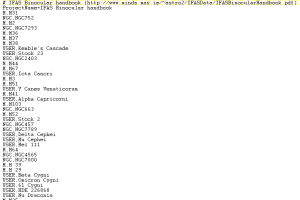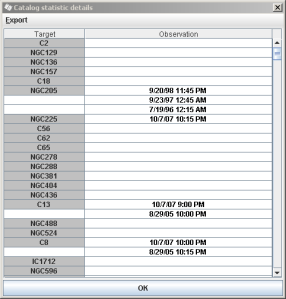Archive
Introducing observation projects
In one of the previous blogs, I mentioned observation projects which will be introduced with Observation Manager 0.920.
An observation project for OM is a list of celestial objects, that an observer wants to observe. Technically an observation project is a plain text file containing a list of object names.
The new Deep-Sky extension that comes with OM 0.920 already delivers one observation project, the Herschel 400 list.
But you are free to add you own observation projects to OM!
Creating such an observation project for OM is quiet easy.
Create a text file in the /project folder underneath the OM installation directory. Make sure the file extension of that text file is *.omp.
In this text file you can add a list of objects you want to observe in this particular project.
Each line should consist of one object and the catalog where the object can be found.
Example: You wanna add M13 to your observation project. Add a line: M, M13
The M indicates the catalog where the object can be found. M stands for the Messier catalog (you could also write Messier). The comma is used as delimiter and then comes the object name, in this case M13.
Objects which can be found in the NGC catalog, should use NGC as first entry. Caldwell objects should use C, Objects from the Index Catalog should use IC.
But how to deal with objects that are not part of any catalog that is shipped with OM? Just prefix those entries with: USER
Here’s an example:
As you can see in the example. Each line consists of one object entry, and each entry starts with the catalog abbreviation followed by a comma and the object name.
Optionally you can add a project name (which will later be used by OM). The project name entry should look like this:
ProjectName=<yourProjectName>
Your done! Now open OM and create statistics on your observation projects.
Question: Why do I have to enter the catalog name for each object?
Answer: To be honest, you don’t have to. I’ll also work if you just place the object name into the line, without the catalog name as prefix.
But there are two good reasons to give the catalog name for all objects in your observation project:
a) Performance: Without explicitly knowing which catalog the given object can be found, OM starts a search through all existing catalogs to find the object. This takes a while! You might notice this when you open OM and directly call the “Show statistics” from the menu bar. Some wait pop-up will appear as OM is still loading the projects. (OM loads all projects directly after startup)
b) Consistency: As outlined above. If you don’t explicitly add catalog names for object entries, OM starts searching for an object in all available catalogs. In which sequence OM searches through the catalogs is not predictable. This might lead to the fact that OM finds your entry in some other catalog, as you intended/thought.
Let’s see an example:
The given observation project (at the left) is totally valid. But as I stated above, it’s not a good idea to list objects without their catalog. Let’s see how the observation project looks after OM loaded the project:
As you can see, even if the list in the observation project text file consists only of NGC entries, OM lists e.g. Caldwell objects in this list. Why is that the case?
As stated above. Without any catalog name given in the text file, OM starts searching for the object in all available catalogs. And as e.g. NGC185 equals Caldwell18 OM found C18 first.
To sum this up: Always give catalog names!





Recent Comments